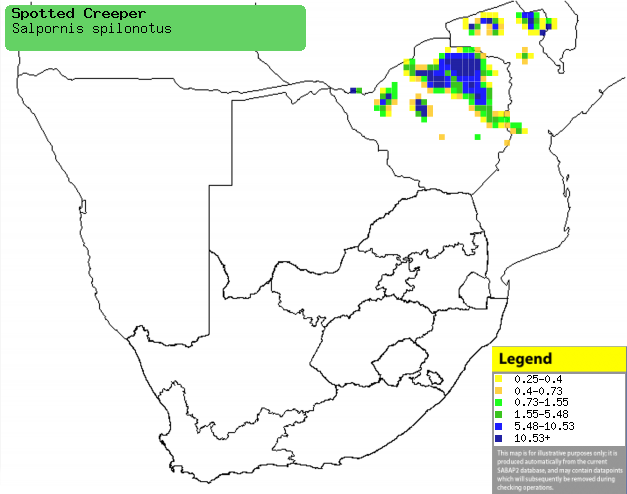|
Salpornis spilonotus (Spotted
creeper)
Boomkruiper [Afrikaans]; Gevlekte boomkruiper [Dutch];
Grimpereau tacheté [French]; Fleckenbaumläufer, Stammsteiger [German];
Trepadeira-malhada [Portuguese]
Life
> Eukaryotes >
Opisthokonta
> Metazoa (animals) >
Bilateria >
Deuterostomia > Chordata >
Craniata > Vertebrata (vertebrates) > Gnathostomata (jawed
vertebrates) > Teleostomi (teleost fish) > Osteichthyes (bony fish) > Class:
Sarcopterygii (lobe-finned
fish) > Stegocephalia (terrestrial
vertebrates) > Tetrapoda
(four-legged vertebrates) > Reptiliomorpha > Amniota >
Reptilia (reptiles) >
Romeriida > Diapsida > Archosauromorpha > Archosauria >
Dinosauria
(dinosaurs) > Saurischia > Theropoda (bipedal predatory dinosaurs) >
Coelurosauria > Maniraptora > Aves
(birds) >
Order: Passeriformes > Family: Certhiidae
Distribution and habitat
Occurs in India and sub-Saharan Africa, where its
population is distributed in patches from Senegal to Ethiopia south to southern
Africa. Here it is generally uncommon in Zimbabwe and central Mozambique,
preferring the mid and lower canopy of climax miombo (Brachystegia) and
munondo (Julbernardia) woodland, rarely moving into other broad-leaved
woodland types.
|
 |
|
Distribution of Spotted creeper in southern
Africa, based on statistical smoothing of the records from first SA Bird
Atlas Project (©
Animal Demography unit, University of
Cape Town; smoothing by Birgit Erni and Francesca Little). Colours range
from dark blue (most common) through to yellow (least common). |
Food
It eats arthropods taken from crevices in the bark of
trees, working its way from the base up the trunk in a spiral-like movement and
often joining mixed-species foraging flocks. The following food items have been recorded
in its diet:
Breeding
- The nest is a high-walled, open cup built of grass, hairy flower stalks,
leaf petioles, lichen, bark and chips, secured with spider web and cottony
plant material. It is typically placed 3-12 metres above ground in an
upright forked branch or horizontal branch, well camouflaged especially from
below.
- Egg-laying season is from August-October, peaking during September.
- It lays 2-3 eggs, which are incubated solely by the female, who is fed
daily by the male.
- The chicks are brooded by both parents, and are fed on a diet of mainly
caterpillars and moths.
Threats
Fragmentation of miombo (Brachystegia) woodland in
Zimbabwe is cause for concern.
References
-
Hockey PAR, Dean WRJ and Ryan PG 2005. Roberts
- Birds of southern Africa, VIIth ed. The Trustees of the John Voelcker
Bird Book Fund, Cape Town.
-
Harrison, J.A., Allan, D.G., Underhill, L.G., Herremans, M.,
Tree. A.J., Parker, V. & Brown, C.J. (eds). 1997. The atlas of southern
African birds. Vol. 2: Passerines. BirdLife South Africa, Johannesburg.
|
